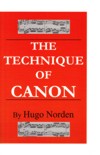
The Technique of Canon
Norden, Hugo
Branden Press Publishers. 2009Ficha técnica
- EAN: 9780828321907
- ISBN: 978-0-8283-2190-7
- Editorial: Branden Press Publishers
- Fecha de edición: 2009
- Encuadernación: Rústica
- Dimensiones: 14x21,5
- Idioma: Inglés
- Nº páginas: 216
Agotado
Agotado en la editorialPVP. 31,05€
Añadir a la Lista de deseos
The late Hugo Norden taught at Berkley and at Boston University. He was also a composer of light and serious music, as well as the author of several books on music and on composition. His Technique of Canon is by far his most popular. It continues to be used as a manual by serious composers throughout the world.
Here, for the first time anywhere, the precise processes for composing any kind of canon are made available to the music world. Never before -as far as can be determined- have these principles been set down for use by composers, musicologists, students and teachers. Hugo Norden's The Technique of Canon is historically and musically, a landmark in every sense of the word.
The composer is given the technique needed to construct systematically whatever type of canon meets his creative requirements, and the musicologist is able to demonstrate the writing of any canon by any composer of any period. (In fact, included among the many musical examples are reconstructions of several of the more subtle canons by Bach and Haydn.) No longer need canons be written by a trial and error method, nor any detail of this important aspects of the composer's art be left to chance.
The Technique of Canon is a far-reaching work wich provides a systematic and reliable basis for the composition of canons, and opens as well new avenuesfor constructing and organizing harmonies with fresh concepts of ingenuity and sophistication. The principles set forth in this outstanding book trascend all stylistic barriers, and are as effective in the contemporary idioms of our day as they were in the time of Okeghem, Byrd, and Bach.
CONTENIDO:
Introduction: The Double Counterpoint Principle
Double Counterpoint
Canon in Two Parts
Invertible Canon in Two Parts
The Spiral Canon, Canonic Recurrence
Canon in Contrary Motion
The Crab Canon
Crab Canon in Contrary Motion
Canon in Three Parts, I
Canon in Three Parts, II
Canon in Four and More Parts, Canon with Unequally Spaced Entrances
Canon in Augmentation, CAnon in Disminution
The Round
Canonic Harmony
Embellishment




